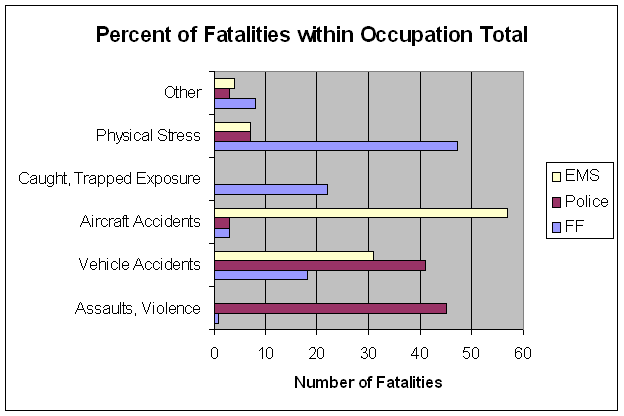Public Safety Sector Description
NOTE: This page is archived for historical purposes and is no longer being maintained or updated.
In 2009, the Bureau of Labor Statistics (BLS) estimated nearly 2 million career public safety workers were employed in corrections, emergency medical services, fire fighting, and law enforcement. More than 1 million volunteers provide fire fighting and emergency medical services in many locations throughout the country. A variety of occupational hazards potentially affect the health of these workers.
Public Safety Worker Population
| Occupational Group | Local | State | Federal |
|---|---|---|---|
| Police & Detective Supervisors | 78,020 | 13,040 | 6,560 |
| Fire Fighter Supervisors | 53,780 | 2,660 | |
| Corrections Supervisors | 14,550 | 28,090 | 1,380 |
| Police, Sheriff & Detectives | 602,730 | 76,400 | 54,960 |
| Fire Fighters (Career) | 279,530 | 5,900 | 8,780 |
| Fire Fighters (Volunteer) | 812,1501 | ||
| Corrections Workers | 160,310 | 256,880 | 15,590 |
| EMT & Paramedics (Career) | 64,120 | 1,350 | |
| EMT & Paramedics (Volunteer) | 244,4082 |
Sources: BLS May 2009 National Industry-Specific Occupational Employment and Wage Estimates
1 National Volunteer Fire Council Fire Service Fact Sheet (2011)
2 EMS Workforce for the 21st Century: A National Assessment (June 2008)
The North American Industry Classification System (NAICS) codes for this group are:
| 92212 | Police Protection |
| 92214 | Correctional Institutions |
| 92216 | Fire Protection |
| 115310 | Firefighting, forest |
| 62191 | Ambulance Services |
For more information about the Public Safety sector, please see the North American Industry Classification System (NAICS) Web site
Employment data, such as occupational titles, numbers employed, and salary distributions can be accessed through the links below.
NAICS Codes for:
999000 – Federal, State, and Local Government
SOC Group 33-000 – Protective Service Occupations


Health Risks and Fatalities
States with Federally-approved Occupational Safety and Health programs provide Survey of Occupational Injuries and Illnesses (SOII) data on government employees to the Bureau of Labor Statistics (BLS). These sparse data are available on occupational injury and illness risks for public safety workers in the U.S. SOII data that are provided by a few States and indicate elevated risks for injuries due to assaults and violent acts for police and corrections employees. Firefighters experience occupational injuries due to overexertion and overexertion with lifting. Transportation incidents are the leading cause of occupation fatalities for local and state police, as well as firefighters. Assaults and violent acts are also frequent causes of fatalities for local police, and falls cause many firefighter deaths.

Source: Rand 2004 (Draft NEISS Data, 1996-1998)
Effective interventions would reduce injury and fatality risks among public safety workers, especially for transportation incidents. The Public Safety Sector Council has identified the needs for many specific interventions. The Sector Agenda also stresses the need for more complete surveillance data and analysis.
Questions or Comments?
If you have any questions or comments, contact the NORA Coordinator, or the Public Safety Program Coordinator at
- Page last reviewed: December 3, 2012 (archived document)
- Content source:
- National Institute for Occupational Safety and Health (NIOSH) Office of the Director


 ShareCompartir
ShareCompartir